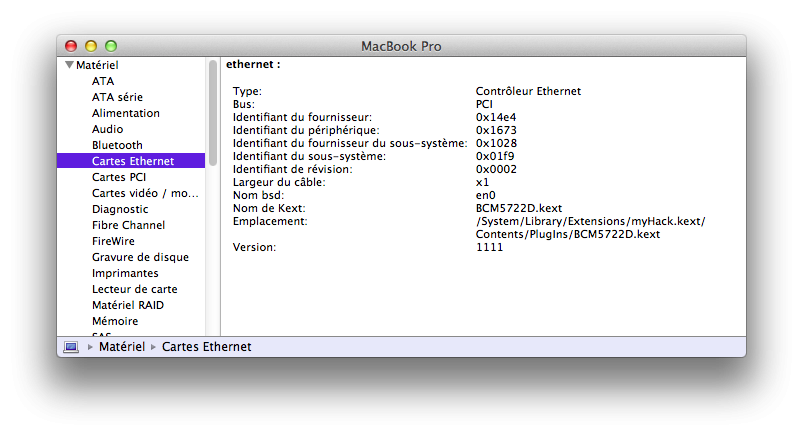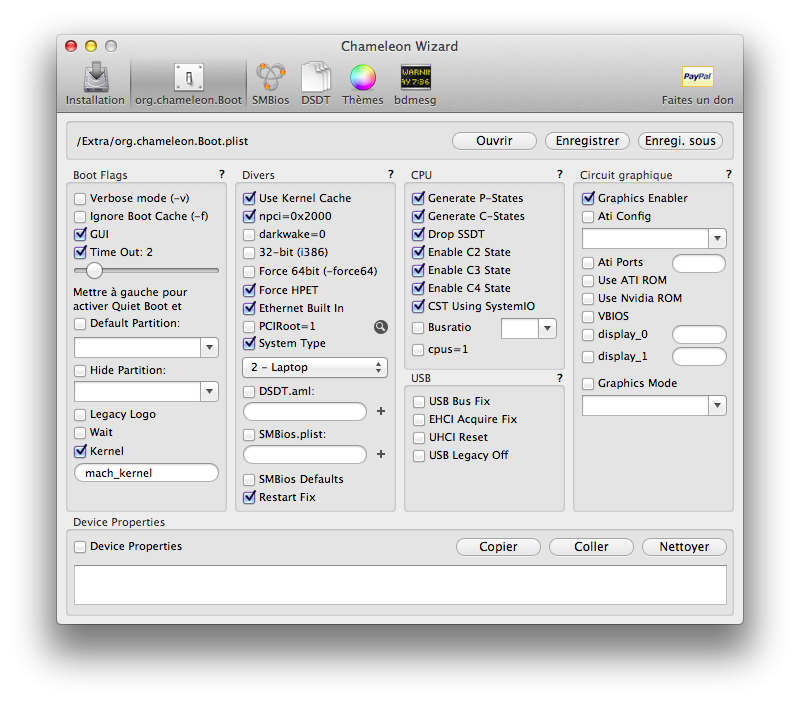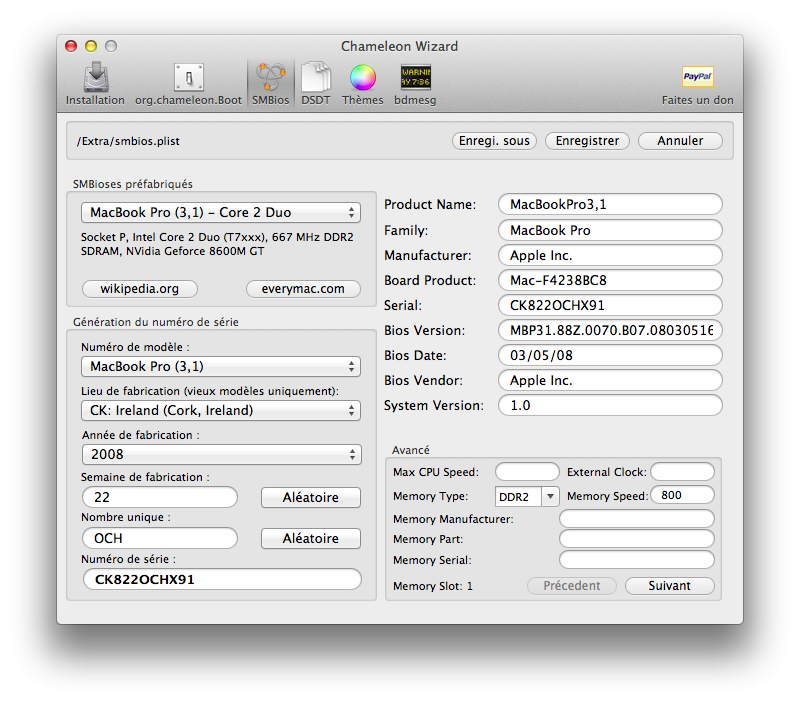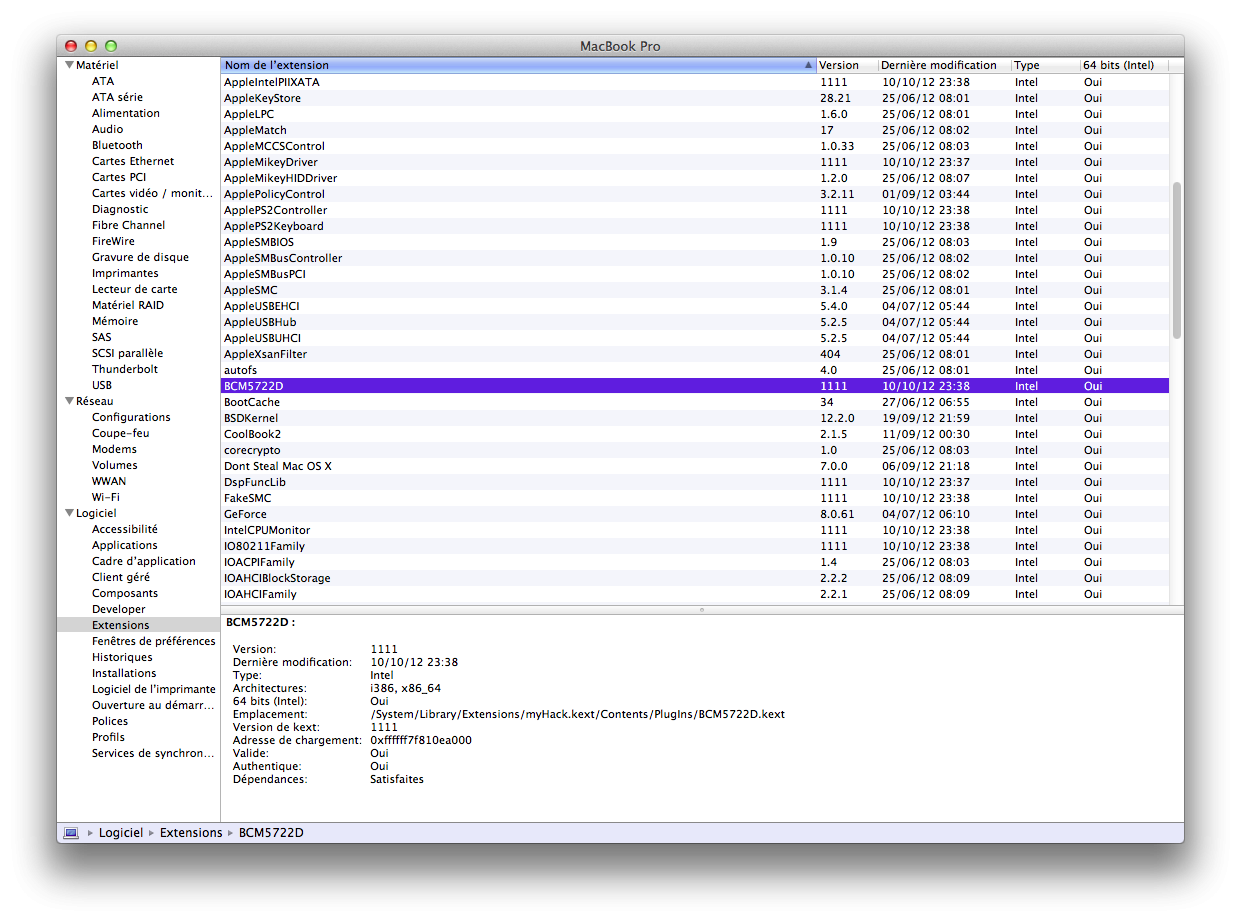-
Posts
10068 -
Joined
-
Last visited
-
Days Won
569
Content Type
Profiles
Articles, News and Tips
Forums
Everything posted by Hervé
-
You were running version 3 rev 424. EDP is now on version 4, so you can't update v3 any more through the menu. Just download EDP again and install it. You will then be up to v4 r12.
-
Did you add the EDP Bootpack for D630 nVidia through myHack (=Create /Extra) after creating the SL installation key? Are you running on one of the latest BIOS like A17 or A18?
-
No other choice but change CPU I'm afraid, unless you're a BIOS re-programming genius who can make the BIOS report your Core Duo as a C2D... Provided your computer supports Core 2 Duo CPUs (a D620 does), upgrade to a C2D. Have a look at Intel's web site for the T7000 family for details. Then, you can look on a well known online bidding site to find one for pennies. Simply check your computer specs, max FSB and socket type and go for a C2D with matching specs. Eg: a T7200, FSB667, 2.0GHz, socket M in a D620.
-
Ja, ja, 'was just joking! To me, it's very difficult to say. No two persons will have the same idea of "the best" laptop. Unlike desktop, it's not possible to build your own laptop, so it's a matter of comparison between HW supported by Apple and best-matching equipment from laptop manufacturers. And of course, for less $$$ than a MacBook. As for running "whatever gets released next", you can never be too sure... Look at how Apple just dumped support for older 64bit Macs when they introduced ML. You never know what they'll do next.
-
At the moment, probably a MacBook Pro Retina!
-
To be honest, don't bother. You can't get graphics acceleration with the Intel X3100 (no 64bit kext + higher graphics requirements needed on ML, like for OpenGL) and those who tried to run ML without acceleration on D630 eventually gave up. Without a supported GPU, graphics performance is bad (I'm told displaying things as trivial as menu bar items now calls on the GPU) as everything has to rely on the CPU itself. On top of that, your Vostro does not possess the most performing C2D (2Mo cache, 1.4GHz ) ... It'd be more sensible to try and run it with Lion. I think you really are wasting your time. But, should you wish to persist... re:DSDT table, you could try to build your own. Have a look at Olarila web site. You can extract a table from Windows (if you can still run Windows on that Vostro) and patch it before you compile it. Try and post your BIOS settings, there could be something to modify. Which bootloader do you use?
-
I would not worry too much about not seeing any BT items in the Network Pref Pane, unless you use PAN or DUN with a bluetooth. device. In fact, these 2 may require to be added manually -> Press "+" button and see what's offered in the list of interfaces. In the System Preferences however, you should see the BT icon. The other way to open the BT Pref Pane is to click on the menu bar icon and select "Open Bluetooth preferences...". Re: on-board Ethernet, I'd expect the same HW on all D630:
-
Just stick it in. You'll see soon enough it it works or not...
-
-
Windows settings are of little/no use. The hardware specifications are what's required: CPU, Graphics card, Wireless card, Bluetooth, HDD type, etc. The global specs are available off Dell's web site, but there are always specific items like CPU model and/or graphics cards (built-in chipset or discrete card). Your BIOS + Windows device parameters should help you dress the list of HW components of your laptop.
-
Are you still trying to run ML or did you fallback to Lion?
-
Nothing specific ever done; it just works, so never had reason to think about it. I still have to test this reported disconnection issue under high traffic though... I'll put a copy of my Chameleon boot plist + SMBIOS details later on, in case the answer lies somewhere in there; doubt it though...
-
I'm typing this having switched off Wifi, plugged in the Ethernet, put the laptop to sleep by closing the lid and waking it by opening the lid. So the answer is: Yes The loaded kext is that provided by the myHack library:
-
As they say in many garages: "They all do that, Sir!" -> http://forum.osxlati...17-1082-update/
-
In your case, you were in the same situation as the D630 with Intel Crestline X3100 graphics where a specific DSDT table is required per LCD resolution (WXGA 1280x800 vs. WXGA+ 1440x900). On the D830, there are 3 different LCD resolutions: WXGA 1280x800, WSXGA+ 1680x1050 and WUXGA 1920x1200. It appears the only available bootpacks are for WXGA and WUXGA resolution; nothing for WSXGA+, which you had. As such, whatever bootpack you used during installation did not suit the actual H/W, hence black screen (a typical symptom) and other issues. If you still possess that LCD, we could probably create a specific DSDT table and update the bootpack list for that screen size. D630 with nVidia graphics is not affected by this resolution-based DSDT issue and I would expect the same for the D830. The issue in gbrown69's case seems to be nVidia 140m related, whereas nVidia 135m laptops are generally Ok. It'd be interesting to know if he met success on the nVidia 135m model he had mentionned.
-
Will try. I have that BCM5722d kext installed, but never actually use the wired Ethernet, just Wifi.
-
I've updated from v4r7 to v4r12 (not that I actually needed to, but...) and now have the same kext in /S/L/E as I had in /E/E. But is that kext actually loaded?
-
For info, here's what I have on my D630 nVidia when reading file info: - in /S/L/E: AppleACPIPlatform.kext, version 1.6, size 569 757 bytes - in /E/E: AppleACPIPlatform.kext, version 1.3.5, size 2 280 797 bytes The loaded kext is indeed loaded as version 1111 from /SL/E myHack kext plugins folder (size 1 806 582bytes). Does this mean that the kexts in /E/E and /S/L/E could both be removed?
-
I've tried other kexts, reported operational under Lion, but no success. Whilst these PCMCIA kexts fully support the Cardbus card, they always cause loss of Wireless. So, this is still an open matter being worked on. Meantime, the above kext can be used as an awkward workaround, but not a permanent solution. At least on Lion. It probably works ok on Kurt's SL 10.6.1. Kurt, could you confirm?
-
Which Trackpad/Mouse controller do you use?
-
Hi, it'd be a good idea to provide the specifications of your D620 to start with. Provided you have the correct CPU (Lion needs Core 2 Duo minimum) and you followed the EDP-based procedure available here, you should have no problem at all.
-
Try a different Mouse/Keyboard kext maybe. VoodooPS2 controller usually works very well. ANV-Slice too.
-
I can run a different type of VPN application/service without issue on my D630s (Juniper Netwok Connect). Tested Ok under SL, Lion and ML with Network Connect 6.5.0 and 7.1.0. It also works on my Inspiron 6000 under Leopard.
-
'haven't used SL for a while now, but great success wth Lion on D630 intel X3100. No issues whatsoever with various EDP versions (from v2.2 to various v3 and now v4).
-
And here's another log following another 20s shutdown: SystemUIServer.app' [178] for authorization created by '/System/Library/CoreServices/SystemUIServer.app' [178] (B,0) Oct 5 10:01:49 --- last message repeated 1 time --- Oct 5 10:01:48 id630ml com.apple.launchd.peruser.501[164] (com.apple.PackageKit.InstallStatus): Throttling respawn: Will start in 9 seconds Oct 5 10:01:49 id630ml.home com.apple.ShareKitHelper[309]: --warning: [shareKit-XPC] Received XPC_ERROR_CONNECTION_INVALID Oct 5 10:01:49 id630ml.home com.apple.ShareKitHelper[309]: --warning: [shareKit-XPC] connectionWithClientInterrupted Oct 5 10:01:49 id630ml.home com.apple.ShareKitHelper[309]: --warning: [shareKit] Cancel UI for running services with Client PID: 245 Oct 5 10:01:49 id630ml.home WindowServer[93]: dict count after removing entry for window 0x1f is 0 Oct 5 10:01:49 id630ml.home WindowServer[93]: CGXGetConnectionProperty: Invalid connection 43779 Oct 5 10:01:49 --- last message repeated 4 times --- Oct 5 10:01:49 id630ml com.apple.launchd.peruser.501[164] (com.apple.talagent[177]): Exited: Killed: 9 Oct 5 10:01:49 id630ml com.apple.launchd[1] (com.apple.ShareKitHelper[309]): Exited: Killed: 9 Oct 5 10:01:49 id630ml.home coreservicesd[62]: SendFlattenedData, got error #268435459 (ipc/send) invalid destination port from ::mach_msg(), sending notification kLSNotifyApplicationDeath to notificationID=136 Oct 5 10:01:49 --- last message repeated 2 times --- Oct 5 10:01:49 id630ml com.apple.launchd.peruser.501[164] ([0x0-0x1a01a].com.apple.AppleSpell[251]): Exited: Terminated: 15 Oct 5 10:01:49 id630ml com.apple.launchd.peruser.501[164] (com.bjango.istatlocal[216]): Exited: Terminated: 15 Oct 5 10:01:49 id630ml.home WindowServer[93]: CGXGetConnectionProperty: Invalid connection 43779 Oct 5 10:01:49 --- last message repeated 4 times --- Oct 5 10:01:49 id630ml com.apple.launchd.peruser.501[164] ([0x0-0xf00f].com.apple.iTunesHelper[220]): Exited with code: 1 Oct 5 10:01:49 id630ml com.apple.launchd.peruser.501[164] (com.apple.mdworker.shared.04000000-0000-0000-0000-000000000000[1285]): Exited: Killed: 9 Oct 5 10:01:49 id630ml.home coreservicesd[62]: SendFlattenedData, got error #268435460 (ipc/send) timed out from ::mach_msg(), sending notification kLSNotifyApplicationDeath to notificationID=241 Oct 5 10:01:50 id630ml.home loginwindow[43]: DEAD_PROCESS: 43 console Oct 5 10:01:50 id630ml.home WindowServer[93]: CGXGetConnectionProperty: Invalid connection 43779 Oct 5 10:01:50 --- last message repeated 4 times --- Oct 5 10:01:50 id630ml.home coreservicesd[62]: SendFlattenedData, got error #268435459 (ipc/send) invalid destination port from ::mach_msg(), sending notification kLSNotifyApplicationDeath to notificationID=131 Oct 5 10:01:50 id630ml.home com.apple.kextd[12]: /: giving up; kextcache hit max failures Oct 5 10:01:50 id630ml.home shutdown[1299]: halt by admin:







